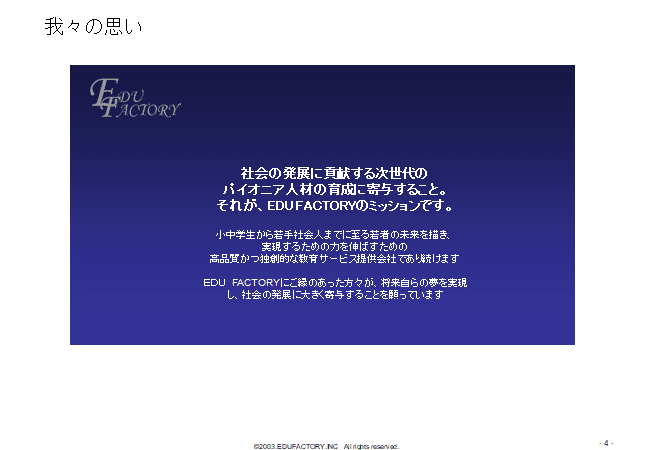
戦略コンセプトはどのように生み出されるのか?
前回の記事では、戦略ストーリーに一貫性をもたらすにはコンセプトが必要であり、コンセプトは自分たちは何者かというアイデンティティと、顧客にどのような価値を提供するかというコアバリューから構成されるという話をしました。
今回の記事では、コンセプトはどのように生み出されるのかを考えたいと思います。
ヴィジョンとコンセプトは表裏一体のもの
まず、コンセプトとヴィジョンの関係について考えたいと思います。ヴィジョンとコンセプトは表裏一体のものであり、切っても切り離せないものになるからです。
当社の例でいえば、当社の2025年ヴィジョンの1つとして以下を掲げています。
「育成の成果にこだわる」を基本コンセプトとして、国内大企業育成マーケットにおけるトッププレイヤーになっている
当社のヴィジョンの中には、「育成の成果にこだわる」というコンセプトが明示的に含まれています。ヴィジョンには、必ず明示的にコンセプトが含まれていなければいけないというわけではありませんが、ヴィジョンとコンセプトはお互いに密接に関わっています。
ヴィジョンとコンセプトの関係は、「コンセプトを具現化し続けることで、ヴィジョンの実現につながる」という関係になっています。当社の例でいえば「育成の成果にこだわる」ということを体現し続けることによって、国内大企業育成マーケットのトッププレイヤーという将来像につながるという関係です。
ヴィジョン(将来像)
↑(具現化し続ける)↑
コンセプト
=
アイデンティティ(自分たちは何者か)
+
コアバリュー(顧客にどんな価値を提供するか)

いいコンセプトは、世の中の「意識の偏在の解消」に結びつく
いいヴィジョンの要件の一つとして「意識の変容を伴う」ということをヴィジョンの章の記事でお伝えしました。そして、その変容が、世の中の意識の偏在を解消するという大きなレベルのものになっているときに、ヴィジョンが大きなインパクトをもたらすことをお伝えしました。
ある事象の背景には、それを具現化している意識とエネルギーの流れがあります。ある現実が理想とはギャップのあるものだった場合、その背景にある意識も、本来あるべき流れではなくなっていると考えます。それが「意識の偏在」です。
いいヴィジョンは、この「意識の偏在の解消」につながっているということを上記のnoteでお話ししています。
コンセプトとヴィジョンは表裏一体のものですから、いいヴィジョンが「意識の偏在の解消」に結びつくことと同様に、いいコンセプトも「意識の偏在の解消」に結びついています。

再びスターバックスを例に説明します。サードプレイスというコンセプトが発想される前は、いわゆるファーストプレイス(自宅)とセカンドプレイス(職場)の往復が、多くの人々の日常でした。人々の意識としてはこの現実を当然のものとして受け入れていますが、本来の人間らしい生活はどうありたいかということについての世の中全体の意識の流れとはギャップがあるかもしれない。この気づきがスターバックスが注目した「意識の偏在」です。
この気づきを元に、顧客の観察と対話を繰り返す中で、サードプレイスというコンセプトが誕生したのだと思います。
ヴィジョンとコンセプトの構想プロセスは同じ
コンセプトを構想するより詳細なプロセスは、ヴィジョンの構想と同じです。ヴィジョンとコンセプトは同時に構想されることも多いと思います。状況や文脈によっては、ヴィジョンとコンセプトのどちらかだけを構想する場面もあると思います。
ヴィジョンの構想プロセスについては、以下のnoteならびにそれに続く一連の記事をご覧いただければと思います。
これらの記事をまとめるとヴィジョンの構想プロセスは以下となります。
ヴィジョンの構想プロセス
① 主体的真理から始める
② 意識の自然な流れと、意識の偏在のギャップに注目する
③ 問いを立て、直感を活用する
④ 対話とマッシュアップによって、ヴィジョンを共創する
コンセプトについての構想プロセスもこれと全く同じになります。
コンセプトの構想プロセス
① 主体的真理から始める
② 意識の自然な流れと、意識の偏在のギャップに注目する
③ 問いを立て、直感を活用する
④ 対話とマッシュアップによって、コンセプトを共創する
詳細な内容については、ヴィジョン構想プロセスと殆ど同じになりますので割愛しますが、当社においてサービスコンセプトを生み出した事例を一つご紹介することで、この構想プロセスの具体的なイメージをもって頂ければと思います。
当社の創業時のコアプロダクトは「100本ノック」という研修プログラムでした。これは「習うよりも慣れろ」というコンセプトを具現化したものであり、研修時間においてインプットの時間を最小化して、アウトプットしながら学ぶ時間を最大化するような構成になっています。
「習うよりも慣れろ」というコンセプト、そして「100本ノック」という商品名は、創業期においてお客様・社内メンバーの共感を得ることができ、当社の創業期の成長の原動力となりました。
これらのコンセプトが当社の中でどのように生み出されたかをご紹介したいと思います。
①主体的真理から始める
当時の我々の思いは、「社会の発展に貢献する次世代のパイオニア人材の育成に寄与する」というものでした。

パイオニア人材というと、「一部の優秀な人たちの育成」という印象があるかもしれませんが、そうではなく「誰でもパイオニア人材になれる」という前提を持っていました。100本ノックが生まれてくる前提として「誰でもやればできる」という強い信念がありました。
② 意識の自然な流れと、意識の偏在のギャップに注目する
当時の研修スタイルは、講師が一方的に話をして、受講生はその内容を静かに聞くというものが主流でした。そして、それが当時としては「当たり前」の研修スタイルでした。
しかし、私たちは、ここに疑問を持ちます。わかることと、できることにはギャップがあるのではないか、そして、そのギャップが埋まらないと、実際の仕事における成果に結びつけることができないのではないか。
また、自分たちでセミナーを実施する経験から、受講生はただ聞いているだけよりも、発表をした内容に対して講師からフィードバックをもらったり、受講生同士でディスカッションしたりするような、アウトプットする場に価値を見出していることを感じていました。
そのような経緯から、「講師が一方的に話す研修スタイル」という意識の偏在に注目したのです。
③ 問いを立て、直感を活用する
「では、どのような研修であれば、受講生がより楽しく取り組むことができ、実際の仕事における成果に結びつくか」という問いが立ちます。

そのような問いに対して、思い浮かぶ内容は、創業メンバーそれぞれの前職であるコンサルティング会社の経験でした。コンサルティング会社においては、アウトプットした内容に対して先輩コンサルタントからたくさんのフィードバックをもらいます。
このフィードバックをもらいながら、自分のアウトプットを改善していくことで、お客様に提示する成果物に昇華されますし、自分の成長にもつながります。要は、アウトプットすることによって、学んでいたのです。
また、私個人は、大学時代に打ち込んだテニスの経験を思い浮かべました。とても緊張する試合において、自信をもってプレーするためには、練習において100回繰り返し再現できるようなショットを身につけておかなければいけません。このためには、徹底的な反復練習が必要となります。
④ 対話とマッシュアップによって、コンセプトを共創する
問いに対する気づきや直感を、創業メンバー3人で共有して、対話とマッシュアップをしていきます。「わかるとできるのギャップ」、「反復練習が必要」、「アウトプットとフィードバック」、このようなキーワードをホワイトボードに書き出しながら話し合いました。
その中で、3人の誰かがふと「これ、100本ノックじゃない」と言ったときに、頭の中で衝撃が走るような感じを受け、3人がそれぞれの目を見合わせて、「おおー、これだーーー!!」と意気投合したことを昨日のことのように覚えています。

ここまで当社の事例を用いながら、コンセプトが生み出されるプロセスを概観しました。
コンセプトを生み出すことは簡単ではありません。このプロセスを経れば必ず見つかるという類のものでもありません。それは試行錯誤の繰り返し、悶々とする日々の連続という中で、「幸運なことに、あるとき、ふと気づく」というイメージのものかと思います。
ただ、何の準備もなく「幸運なことに見つかる」というものではなく、上記に記載したプロセスを踏みながら、「人事を尽くして天命を待つ」という感じに近いのではないかと思います。
本日の問いとなります。(よろしければ、コメントにご意見ください)
・世の中の「意識の偏在の解消」につながるコンセプトとして、あなたが思い浮かべるものがあるとすれば、それはどのようなコンセプトですか?そのコンセプトは、どのような「意識の偏在の解消」を志していますか?
・あなたが所属するチームのコンセプト(アイデンティティ+コアバリュー)はどのようなものですか?(言語化されていなくても、どのようなイメージをもっているかを意識化してみましょう)
How is a strategy concept created?
In my previous article, I talked about the need for a concept to bring consistency to a strategy story, and that a concept consists of an identity of who we are and core values of what value we provide to our customers.
In this article, I would like to consider how concepts are created.
Vision and concept are two sides of the same coin
First, I would like to consider the relationship between concept and vision. This is because vision and concept are two sides of the same coin, and they are inseparable.
In our case, one of our visions for 2025 is as follows.
With the core concept of focusing on the outcome of training, we become a top player in the domestic training market for large companies.
Our vision explicitly includes the concept of "focusing on the outcome of training". A vision does not necessarily have to explicitly include a concept, but vision and concept are closely related to each other.
Vision
↑ (continue to embody) ↑
Concept
=
Identity (who we are)
+
Core values (what value do we provide to our customers)
A good concept can lead to the "resolution of the partiality of consciousness" in the world
In the article in the chapter on visions, I told you that one of the requirements for a good vision is that it must involve a transformation of consciousness. I also told you that visions can have a great impact when that transformation is on the large level of resolving the partiality of consciousness in the world.
In the background of an event, there is a flow of consciousness and energy that embodies it. If a reality is different from the ideal, then the consciousness behind it is not flowing as it should. This is the "partiality of consciousness.
I talked in the above article about how good visions are connected to this " resolution of partiality of consciousness".
Since concepts and visions are two sides of the same coin, just as good visions are linked to the " resolution of partiality of consciousness," good concepts are also linked to the "resolution of partiality of consciousness.

Let me use Starbucks as an example again. Before the concept of the "Third Place" was conceived, many people's daily lives consisted of going back and forth between the so-called First Place (home) and the Second Place (workplace). Although people's consciousness accepts this reality as natural, there may be a gap in the world's overall awareness of what a true human life should be like. This insight is the "partiality of consciousness" that Starbucks has focused on.
Based on this insight, I believe that the concept of Third Place was born through repeated observation and dialogue with customers.
The conceiving process for visions and concepts is the same
The more detailed process of conceiving a concept is the same as conceiving a vision. Often, visions and concepts are conceived simultaneously. In some situations, depending on the situation and context, only one of the two may be conceived.
For more details on the visioning process, please see the following article and the series of articles that follow.
To summarize these articles, the process of envisioning a vision is as follows.
Visioning process
(1)Start with subjective truth
(2)Focus on the gap between the natural flow of consciousness and the partiality of consciousness
(3)Develop "quests" and use one' s intuition
(4)Co-creating visions through dialogue and mashups
The conceiving process for a concept is exactly the same.
Conceptualization Process
(1)Start with subjective truth
(2)Focus on the gap between the natural flow of consciousness and the partiality of consciousness
(3)Develop "quests" and use one' s intuition
(4)Co-creating visions through dialogue and mashups
The details are almost the same as in the visioning process, so I will not go into them here. However, I would like to introduce an example of how we created a service concept so that you can get a concrete idea of this process.
Our company's core product at its early stage was a training program called "100 Fungos." This program embodied the concept of "Get used to it before learning it," and was designed to minimize the time spent on input and maximize the time spent on learning through output.
The concept of "get used to it before learning it" and the product name "100 Fungos" were able to gain the empathy of both customers and internal members during the early days of our company, and became the driving force behind our growth during the early years.
I would like to share with you how these concepts were created in our company.
(1)Start with subjective truth
At that time, our aspiration was "to contribute to the development of the next generation of pioneers who would contribute to the prosperity of society."
The term " pioneers " may give the impression that it is for the development of a few talented people, but this was not the case; the assumption was that anyone could become a pioneer. The premise on which 100 Fungos was born was the strong belief that "anyone can do it if they try."
(2)Focus on the gap between the natural flow of consciousness and the partiality of consciousness
At that time, the mainstream training style was for the lecturer to speak one way and the students to listen quietly to the content. This was the "normal" training style at the time.
But here's a question for us. Isn't there a gap between what we know and what we can do, and if we don't fill that gap, won't we be able to make actual achievements in our work?
Also, from our own experience of conducting seminars, we felt that trainees find more value in output opportunities, such as getting feedback from the lecturer on their presentations and discussions among trainees, rather than just listening to them.
This led us to focus on the partiality of the consciousness of the "lecturers' one-way speaking training style."
(3)Develop "quests" and use one' s intuition
Then, the question(quest) arises as to what kind of training would make the participants more enjoyable to engage in and lead to actual performance on the job.
In response to such a question, what came to mind was the experience of each of the founding members in their previous jobs at consulting companies. At a consulting company, we receive a lot of feedback on our output from senior consultants.
By receiving this feedback and improving our own output, we can sublimate it into a deliverable that we can present to our customers, and also grow as a professional. In short, I was learning by making output.
I also thought of my personal experience of playing tennis in university. In order to play with confidence in a very tense match, I had to acquire a shot that I could repeat 100 times in practice. This requires thorough repetition and practice.
(4)Co-creating visions through dialogue and mashups
The three founding members shared with each other their insights and intuitions about the question, and then engaged in a dialogue and mash-up. We discussed the gap between knowing and doing, the need for repeated practice, and output and feedback, writing these keywords on the whiteboard.
I remember like it was yesterday when one of the three of us suddenly said, "This isn't like 100 fungos in baseball," and I felt a jolt in my head while the three of us looked each other in the eye and said, "Oh, this is it!"
So far, we have outlined the process of creating a concept, using our company's case study.
It's not easy to create a concept. It is not something that you can always find by going through this process. It is more like a series of trial and error, a series of agonizing days, and then suddenly realizing that luck is with you.
However, it is not a matter of "being lucky enough to find one without any preparation”, but more like "doing one' s best and waiting for one's destiny" while taking the process described above.
Here are the quests of the day. (If you'd like, please share your thoughts in the comments.)
・What concept, if any, comes to your mind that will lead to the resolution of partiality of consciousness in the world? What kind of " resolution of partiality of consciousness" does this concept aspire to?
・What is the concept (identity + core values) of the team you belong to? (Even if it's not verbalized, try to be aware of what kind of image the team has.
Bunshiro Ochiai
この記事が気に入ったらサポートをしてみませんか?
